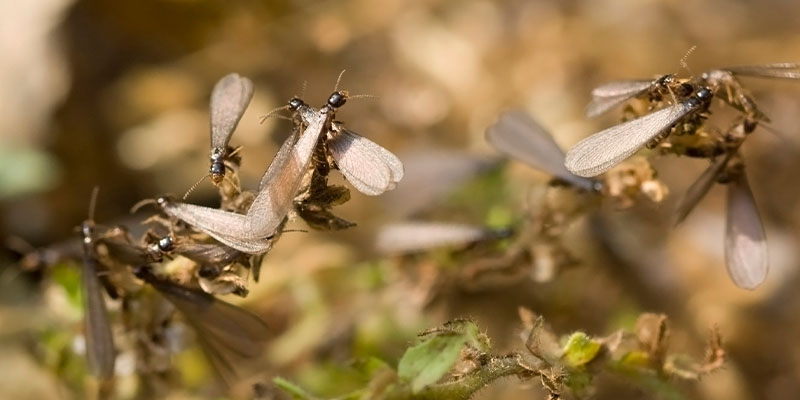Termites are terrifying to homeowners for one simple reason – they can literally tear a house apart. Imagine this. One day, you’re working on a little home improvement project, like replacing the lock on the front door, switching out the old key operated for a new smart, keyless one. Or, replacing outdated window treatments with new ones.
As you work, you notice a strange sight. It looks like sawdust, but you haven’t been using a saw, just a pair of pliers and a screwdriver. Curious, you start to feel the wood and take a closer look. Gradually but surely, it begins to sink in – termites are in your walls!
Instantly, your mind conjures up all kinds of worst-case scenarios and you wonder where else they are in your house. As you scan the immediate room, you don’t see any more outward signs but wonder how far they’ve spread and this brings up a common question: “Can termites fly?” If you want to know the answer, then read on.
Do Termites Fly?
Termites are fascinating insects, often known for their destructive capabilities when it comes to wood and structures. However, one question that frequently arises is: Can termites fly? The answer is both simple and complex. While not all termites can fly, certain members of termite colonies do take to the skies at specific times in their life cycle.
Understanding Termite Castes
Before discussing termite flight, it’s essential to understand the different castes within a termite colony. Termites are social insects with a caste system comprising workers, soldiers, and reproductives. Each caste has distinct roles:
- Workers. Responsible for foraging, feeding the colony, and maintaining the nest.
- Soldiers. Tasked with defending the colony from predators.
- Reproductives. Include the king, queen, and alates (winged termites).
It is the alates, or reproductive termites, that are capable of flight.
What Are Alates?
Alates are young king and queen termites that develop wings and are destined to start new colonies. They are typically darker in color than workers and soldiers and have two pairs of long, equal-length wings.
When Do Termites Fly?
Termite flight, known as swarming, occurs when environmental conditions are just right. Swarming usually happens during warm, humid days, often following rain. This is because moisture and warmth create an ideal environment for termites to thrive. Different species of termites swarm at different times of the year. For example:
- Subterranean termites. Typically swarm in the spring.
- Drywood termites. Swarm late summer to early fall.
- Dampwood termites. Often swarm in the summer.
Why Do Termites Fly?
The primary purpose of termite swarming is reproduction and the establishment of new colonies. When a colony becomes mature, it produces alates. These winged termites leave the nest in large groups, flying in search of a mate and a suitable location to start a new colony. Once they find a suitable spot, they shed their wings, pair up, and begin the process of creating a new termite colony.
How to Identify Flying Termites
Flying termites are often confused with flying ants. However, there are several distinguishing features:
- Wings. Termites have two pairs of wings that are of equal length, while ants have wings of different lengths.
- Antennae. Termites have straight, bead-like antennae, whereas ants have elbowed antennae.
- Waist. Termites have a broad waist, while ants have a narrow, pinched waist.
The Implications of Termite Swarming for Homeowners
Seeing swarming termites near your home can be a genuine cause for concern, as it may indicate a mature termite colony nearby. Here are some steps homeowners can take:
- Inspection. Look for signs of termite activity, such as mud tubes, wood damage, or discarded wings.
- Prevention. Reduce moisture around your home, seal cracks in the foundation, and store firewood away from the house.
- Professional help. Contact a pest control professional to assess the situation and recommend treatment options.
While not all termites can fly, the alates play a crucial role in the life cycle of termites by spreading and establishing new colonies. Understanding termite flight and behavior can help homeowners take proactive measures to protect their property from potential infestations. If you notice flying termites, it’s important to act promptly to prevent potential damage to your home.
How To Prevent a Termite Infestation in Your Home
Termites can be a homeowner’s worst nightmare, causing extensive damage if left unchecked. Here are some effective strategies to prevent these pesky insects from infesting your home:
1. Reduce Moisture
Termites are attracted to moisture, so minimizing damp areas around your home can help deter them:
- Fix leaks. Repair any leaks in pipes, roofs, and gutters to prevent water accumulation.
- Proper drainage. Ensure your home has proper drainage systems in place to avoid water pooling near the foundation.
- Ventilation. Use dehumidifiers and fans in crawl spaces and attics to reduce humidity levels.
2. Maintain Wood and Soil Separation
Termites typically enter homes through direct contact with wood and soil:
- Elevate wood. Keep wooden structures like decks, porches, and fences elevated off the ground.
- Mulch management. Avoid using mulch or wood chips directly against your home’s foundation. Opt for alternative materials like gravel or rubber mulch.
- Firewood storage. Store firewood and lumber at least 20 feet away from your home and off the ground.
3. Regular Inspections
Conduct regular inspections to catch any signs of termite activity early:
- Professional inspections. Hire a pest control professional to conduct thorough termite inspections annually.
- DIY checks. Regularly check for signs of termites, such as mud tubes, discarded wings, and wood damage in your home.
4. Use Termite-Resistant Materials
Incorporate termite-resistant materials in your home construction and repairs:
- Treated wood. Use pressure-treated wood for structures that come in contact with the ground.
- Steel and concrete. Consider using steel frames and concrete foundations instead of wood where possible.
5. Install Physical Barriers
Physical barriers can help prevent termites from accessing your home:
- Termite shields. Install metal termite shields around the foundation and other entry points.
- Sand barriers. Create a barrier of coarse sand around your foundation, as termites find it difficult to tunnel through.
6. Chemical Treatments
Use chemical treatments as an additional line of defense:
- Soil treatments. Apply termiticides to the soil around your foundation to create a chemical barrier.
- Wood treatments. Treat exposed wood with borate solutions to repel termites.
7. Keep Your Home Clutter-Free
Reduce the number of potential termite habitats in and around your home:
- Remove debris. Clear away any debris, dead wood, and tree stumps from your yard.
- Prune vegetation. Trim back plants and shrubs that are close to your home to prevent moisture buildup and reduce shelter for termites.
8. Monitor and Maintain
Stay vigilant and maintain preventive measures:
- Regular maintenance. Keep up with home maintenance tasks to address any potential termite entry points.
- Bait stations. Use termite bait stations around your property to monitor and control termite activity.
By following these preventive measures, you can significantly reduce the risk of termite infestations and protect your home from these destructive pests. If you ever suspect a termite problem, don’t hesitate to contact a professional pest control service for assistance.
Don’t let termites destroy your biggest investment. Trad’s Pest Control offers expert termite solutions to safeguard your home. With proven treatments and years of experience, we stop termites in their tracks. So, call Trad’s Pest Control today and schedule your termite inspection!

